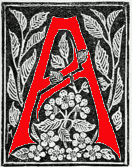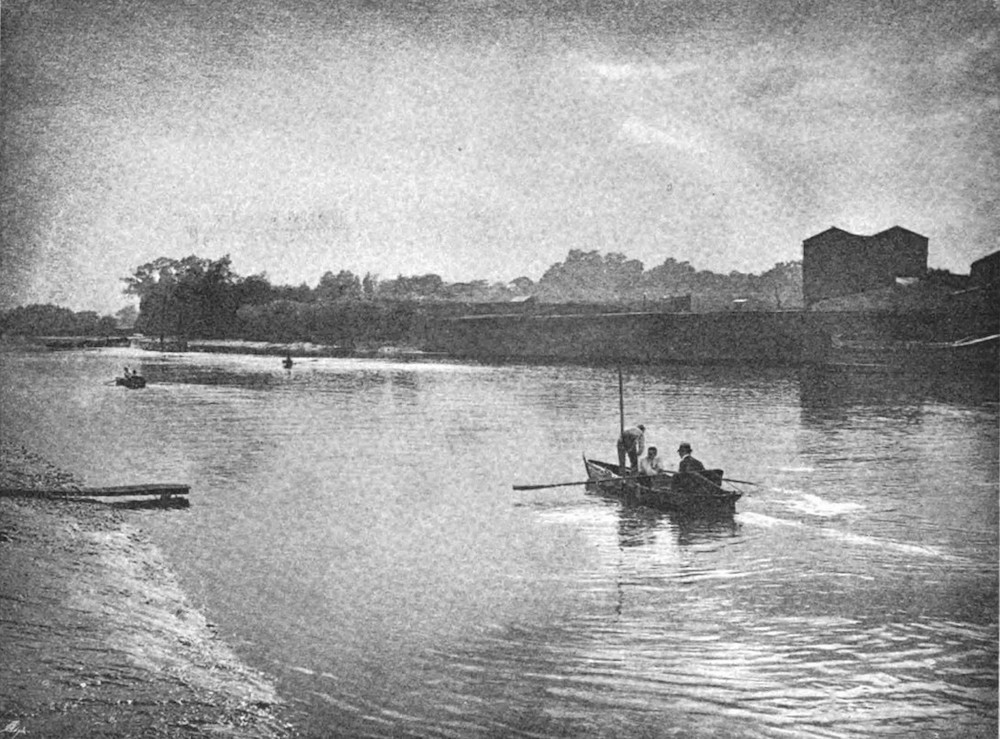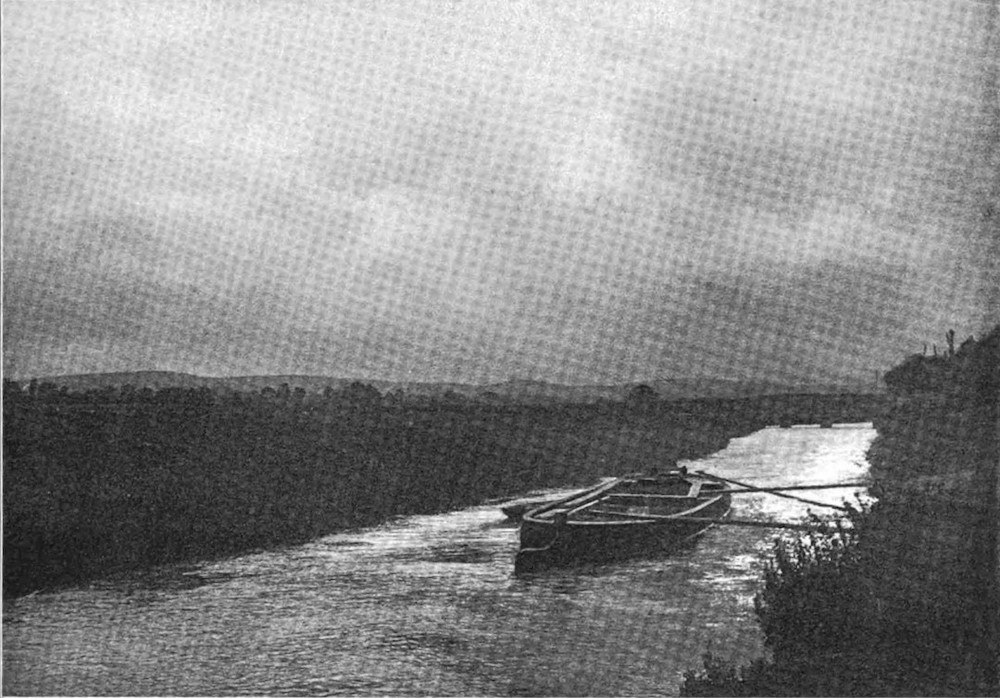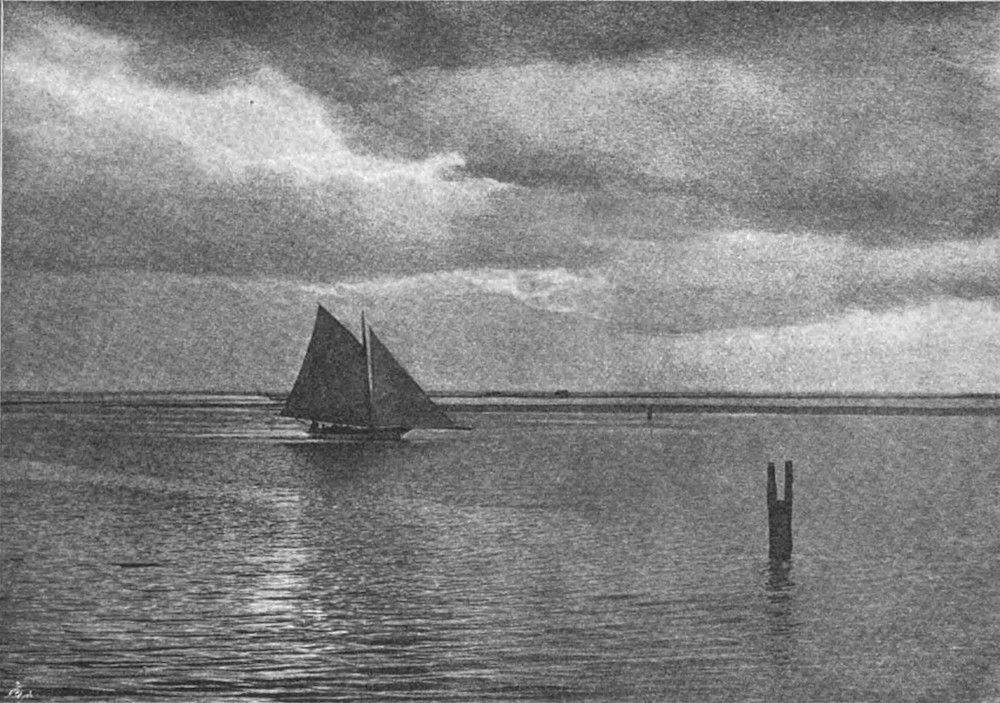The following article has been transcribed from a copy of The Studio (1893) in the Hathi Trust (details in the bibliography), with the addition of some extra paragraph breaks, a few links, and page numbers in square brackets. The scanning process has not been kind to the photographs in the original copy, but they are included here to show at least something of Frederick Hollyer's skills in landscape photography. He seems to have been particularly fond of taking views of rivers, and of having it known that his scenes are "untouched." Only the first photograph, which faces the opening page of the text, is given a name. — Jacqueline Banerjee

COMMONPLACE looking room on the ground-floor of a commonplace house in a quiet Kensington square, the demure plainness of its furniture relieved only by the soft grey tones of the countless platino-type reproductions of the pictures of that apostle of romanticism, Mr. Burne-Jones, which lined the walls. This is where I found Mr. Frederick Hollyer, a sturdy, broad-shouldered, good-humoured and good-looking man of middle age, who comes nearer to the definition of artist-photographer than any other man in England. To the art-loving public in general, and to the section of the American community which deserves that title in especial, Mr. Hollyer is chiefly known and appreciated as the translator into a more popular medium of the poetic fancies of Rossetti and Burne-Jones. To a smaller circle, however, that appreciation is widened into recognition of what may be called, without prejudice, his creative work, as distinct from his reproductive work with the camera. It seemed to me, therefore, eminently fitting that I should come to this modest oracle for a word on the vexed question of art and photography.
As luck would have it I had made my pilgrimage at an opportune moment, for taking advantage of the leisure afforded him by a rare holiday, Mr. Hollyer had, the day before, acquitted himself of a piece of work which I think represents the high-water mark of photographic portraiture. He had deliberately set himself a task, the technical and artistic difficulties of which would to the ordinary man have seemed insuperable. The result, in the shape of a platinum print from the untouched negative, was hanging in his studio to dry, and I was gratified with the first outsider's glance at it. It was simplicity itself; a charmingly pretty girl dressed in a simple summer costume of pure white, standing at an open door, with her fingers resting on the handle as though she were on the point of going out into the little suburban garden, a glimpse of which was caught beyond. The upper part of the figure was seen against a background of absolute sunlight, and yet face, arms, white dress, hair, and dazzling sunlight were all given with a fidelity to values which would not have been unbecoming to a [193/94] Whistler.
In face of this result it seemed to me almost impertinent to ask Mr. Hollyer whether in his opinion there could be such a thing as "Art" in photography, for was there not lying before meas I hesitatingly put my query, a clear answer in the affirmative? He met me, however, with no expression of lofty scorn, but with a somewhat quizzical smile replied, "I really don't know, but to tell the honest truth I have got rather tired of the very words 'art and artistic,' and at times am inclined to say rude things about those who insist so strenuously that they are artists, with a big A, and seem to forget that they ought first and foremost to be photographers. The fact is that my association with the eminent artists whose works I have been permitted to render into black and white by means of my camera, has rendered me exceedingly diffident in making any claims at all. I am content to do the very best work I can with love as well as care, and to let the rest shift for itself. If there be art in the result I am quite sure that those who have a right to be dogmatic on such questions will find it out, if there be no art I am sure it is my fault and not the fault of my medium. I think that the fact is that as regards photography as well as other things we are inclined nowadays to talk too much and to do too little.
"Very truly and modestly put, Mr. Hollyer," said I, "but I am afraid you have something more than an inclination to evade the real point at issue."
"Well," was the reply, "to speak frankly, I am quite convinced that something, call it art or what you will, but something apart from mere mechanical and scientific excellence, not only inclined to say rude things about those who insist so strenuously that they are artists, with a big A, and seem to forget that they ought first and foremost to be photographers. The fact is that my association with the eminent artists whose works I have been permitted to render into black and white by means of my camera, has rendered me exceedingly diffident in making any claims at all. I am content to do the very best work I can with love as well as care, and to let the rest shift for itself. If there be art in the result I am quite sure that those who have a right to be dogmatic on such questions will find it out, if there be no art I am sure it is my fault and not the fault of can, but should, find its way into every print from every negative that leaves the photographer's studio. In landscape photography, for instance, that something may be of the nature of selection, and selection is, as I understand it, an important part of the equipment of every painter. Observation too, I think, must be fostered by the photographer as carefully as by the figure-painter, for if his work show not the presence of this quality in himself it will be a mere piece of mechanism.

Waterloo Bridge. From an untouched photograph by Frederick Hollyer, p.192.
"I have some prints here from negatives taken by me many many years ago, to which I may, I hope without egotism, refer as showing the importance of proper selection. This view of Waterloo Bridge, for [194/95] instance, might have been taken from half a hundred other points of view, and yet from a topographical and mechanical standpoint have been as correct as I here show it. To make it pleasing to my own eye, however, I found there was only one spot from which I could properly view it. Having found this spot I had again to patiently wait until the cloud and mist effects, with the London sun just peeping through the murky veil, were as I thought they should be. Not only this but selection came into play to tell me when the black barge was in the right relative position to the rest of the picture and when other boats and floating objects, which might have formed discordant notes, were well out of the way. The result, whether good or bad, is practically what I had intended it to be from the very first, and is no haphazard accident, but the expression of a deliberate intention, gained by careful selection on my part.
"At that point, of course, I stop, and the rest of the work is done for me by the camera, but I might almost as well declare that the etcher was a mere mechanical workman because the biting of his line is done by the acid and not by himself, as hold that because some portion, granted even that it be the major portion, of my work is done by an agent which I only imperfectly control, I cannot introduce into my work that personal note which I take it is but a synonym for the 'Art' of which you speak. Of course I am aware that at one moment and that perhaps the supreme moment, the actual recording of the observed facts is taken out of the photographer's hands. This is the moment of exposure. Consider on the other hand though, at how many other points the personal equation enters into our problem. First there is the focussing (and though some writers on photography have disagreed with me here, I maintain that I am absolutely correct in saying so); then there is the development; thirdly, there is the manipulation of the print from the developed negative.


From untouched photographs by Frederick Hollyer, pp.193 and 194.
"Don't for one moment understand me to mean that that fatal crime of touching and retouching negative or print is or has been laid to my charge. On the contrary, no one can have a greater abhorrence of such acts than I. I consider it almost as criminal to form a picture by the superposition of one negative upon another. I am convinced that two photographers, equally skilled in the mere mechanical processes of their profession, can photograph the same subject from the same point of view with the same camera, and [195/96]under exactly similar conditions, and that the finished print of one man may be a mere soulless transcript of what lay in his field of view, while that of the other may be something to which for want of a better word, I must apply the term 'artistic.' How much or how little of art may belong to photography is another question, and one which I must refrain from entering upon."
When, not so very many years ago, photography came into being, the marvellous results which were produced by the very earliest photographers, caused an exaggerated opinion to prevail as to its purely artistic future. When, later on, its well-defined limitations became apparent, there was the usual reaction in the other direction, and those who claimed that art might in any form enter into photographer's work were sneered at as presumptuous Philistines. Surely there is safety in the middle course. If you do not deny artistic faculty to the man who reproduces in black and white a picture by means of his patient 'rockings' and 'scrapings' of a copper plate, relying in a large measure upon reproductive processes which are entirely mechanical, why should you not then attribute some degree of artistic personality to him who reaches the same end partially by means of the camera? Compare the work of different men in my own branch, and tell me whether there is not the greatest difference in the result, as regards not only the technical excellence, but the artistic value of the translation as well.


From untouched photographs by Frederick Hollyer, pp.195 and 196.
"Perhaps I have talked too much, for I hold, as I said when I began, that my mission is to do and not to talk. But I am as irritated, on the one hand, when I hear the flat-footed declaration that photography can never be more than a mere mechanical trade, as I am restive on the other when I hear a photographer aver that by combining a set of views taken at various times and hours of the day, he has effected what he fondly calls 'a picture,' as distinct from a 'mere photograph.' In other arts, and especially the subsidiary, it is their very limitations which the craftsmen turn with instinctive recognition to their own advantage. If this principle were only to be recognised and honestly lived up to by photographers in general, we should have results which would be better art, because they would be better photographs."
The other photographs Mr. Hollyer has kindly permitted to be reproduced here show the same discriminative selection as the study of Waterloo Bridge.
Bibliography
Townsend, Horace. "An Interview with Frederick Hollyer." The Studio 1893, Vol. 1. 193-96. Hathi Trust. From a copy in Princteon University Library. Web. 17 June 2023.
Created 17 June 2023